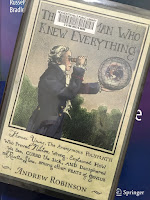 | ||
| The Last Man Who Knew Everything, by Andrew Robinson. |
Young (1773–1829) went to medical school and was a practicing physician. How did he learn enough math and physics to become a biological physicist? In Young’s case, it was easy. He was a child prodigy and a polymath who learned more through private study than in a classroom. As an adolescent he was studying optics and building telescopes and microscopes. As a teenager he taught himself calculus. By the age of 17 was reading Newton’s Principia. By 21 he was a Fellow of the Royal Society.
Some of his most significant contributions to biological physics were his investigations into physiological optics, including accommodation and astigmatism. In Intermediate Physics for Medicine and Biology, Russ Hobbie and I state that the “ability of the lens to change shape and provide additional converging power is called accommodation.” Robinson describes Young’s experiments that proved the changing shape of the lens of the eye is the mechanism for accommodation. For instance, he was able to rule out a mechanism based on changes in the length of the eyeball by making careful and somewhat gruesome measurements on his own eye as he changed his focus. He showed that patients whose lens had been removed, perhaps because of a cataract, could no longer adjust their focus. He also was one of the first to identify astigmatism, which Russ and I describe as “images of objects oriented at different angles… form at different distances from the lens.”
Young’s name is mentioned in IPMB once, when analyzing the wave nature of light: “Thomas Young performed some interference experiments that could be explained only by assuming that light is a wave.” The Last Man Who Knew Everything describes Young’s initial experiment, where he split a beam of light by letting it pass on each side of a thin card, with the beams recombining to form an interference pattern on a screen. Young presents his famous double-slit experiment in his book A Course of Lectures on Natural Philosophy and the Mechanical Arts. Robinson debates if Young actually performed the double-slit experiment or if for him it was just a thought experiment. In any case, Young’s hypothesis about interference fringes was correct. I’ve performed Young’s double-slit experiment many times in front of introductory physics classes. It establishes that light is a wave and allows students to measure its wavelength. Interference underlies an important technique in medical and biological physics described in IPMB: Optical Coherence Tomography.
 |
| A green laser passing through two slits 0.1 mm apart produces an interference pattern. Photo by Graham Beards, published in Wikipedia. |
Young also studied color vision based on the idea that the retina can detect three primary colors. This work was rediscovered and further developed by Helmholtz fifty years later. Young was also one of the first to suggest that light is a transverse wave and therefore can be polarized.
In Chapter 1 of IPMB, Russ and I define the Young’s modulus, which relates stress to strain in elasticity and plays a key role in biomechanics. Young also studied capillary action and surface tension, two critical phenomena in biology.
Was Young a better biological physicist than Helmholtz? Probably not. Was Young a better scientist? It’s a close call, but I would say yes (Helmholtz had nothing as influential as the double slit experiment). Was Young a better scholar? Almost certainly. In addition to his scientific contributions, he had an extensive knowledge of languages and helped decipher the Rosetta Stone that allowed us to understand Egyptian hieroglyphics. He really was a man who knew everything.



Young was a genius in many ways. He changed our understanding of light, last changed by Newton, and influenced future scientists like Maxwell and Einstein. Another great creation was Young’s modulus that is still currently used in many biological studies.
ReplyDeleteYou are right. The double slit experiment, established by Young, but with electrons is a classic test of quantum mechanics.
ReplyDelete